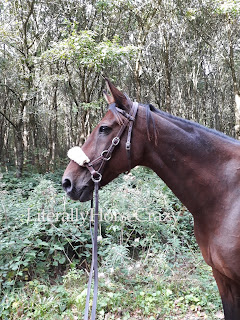Is bitless better?
I love bitless. I ride my horse in a sidepull and used to ride him in a rope halter. I have no intention of putting a bit in his mouth so much – and he hates the bit so much I suspect I could not use one on him again, even if I wanted to. I am delighted when I see that the equestrian world is more and more turning to bitless, even in international jumping competitions.
When I first discovered bitless riding, I was very enthusiastic and had a phase when I was adamant that any kind of bitless bridle was better than any kind of bitted one. And then, as I admired, at shows for instance, as I looked at their expression, as I studied the bridles used, I realised that human imagination knows no limit when it comes to inflicting pain and subduing the spirit of a horse.
One example. I went to the Salon du Cheval in Paris last December. In one of the arenas, different breeds were being presented, from Irish cobs to Arabians. A group of people showing a specific (and rather rare) breed I will not name (I am here to question, not denounce) were riding bitless.
How nice, I thought, as I quickly glanced at them. Then I frowned, and looked more closely. The bridles they were using – which they advertised as their own designed and even offered for sale – was an odd mix between a mechanical hackamore (with big shanks and a lot of leverage) and a rope halter. Not only did it put way too much pressure on the poll, not to mention the nose, but it kept sliding towards the horses’ eyes. Which were full of pain. It did not help that the riders were keeping constant (and harsh) contact on the reins.
I was horrified. This bridle was nightmarish. And the little Irish cob who plodded round the arena in a snaffle looked so much happier than those bitless horses.
Why ride bitless if it is to inflict more pain on your horse? Why design a bridle that is so badly fitted, so badly made, there is no way a horse would ever be comfortable in it? To show off?
Bitless is becoming a thing. And this means it has a darker side. This leads to the multiplication of gadgets that allow people to show off by riding without a bit (but not without pain), and without investing the time needed by a gentle and efficient training. People want to be fashionable. People want to take shortcuts. People think that riding bitless is “brave.” It’s not. Riding bitless is training. Riding bitless is a bond between rider and horse. Riding bitless should be a decision that takes into account what is comfortable for the horse.
The same goes for bridleless riding. I remember I saw, not very long ago, a pucture of someone riding their horse in a neckrope on a racetrack. Impressive. Then it was revealed that the neckrope they used had studs on it, hidden from view but digging into the horse’s flesh. And I wonder, what’s wrong with people? What is the point of pretending you have a great bond with your horse when you’re actually too afraid to trust him? Using pain to control is a cowardly method.
Another way of riding bitless that irks me is when a hackamore is used so low on the horse’s nose that it crushes the soft tissues and barely allows the horse to breath. A hackamore, or any other kind of bitless bridle, should rest on the bone. The point is not to have a breathless horse with constantly flared nostrils and eyes filled with silent agony. Can’t control your horse otherwise? Then spend more time training him. Or go back to using a bit. Because in such cases, I’m sure the horse would prefer a bit.
Is it ignorance, is it stupidity that leads some people to create and/or (mis)use harsh bitless bridles? What infuriates even more than the pain in their horse’s eyes is the smug expression some riders wear: “Look, I’m riding bitless, I’m so brave, I’m so talented, I’m such a good horseperson!”
Riding bitless is not about being brave. It’s not about being fashionable. It’s not about taking shortcuts. If you ride bitless, do it for the good reasons. Do it for your horse, not for yourself.




Comments
Post a Comment